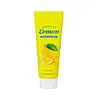What's inside
What's inside
 Key Ingredients
Key Ingredients

 Benefits
Benefits

 Concerns
Concerns

 Ingredients Side-by-side
Ingredients Side-by-side

Water
Skin ConditioningCitrus Junos Fruit Extract
Skin ConditioningCitrus Reticulata Fruit Extract
Skin ProtectingDisodium Cocoamphodiacetate
CleansingGlycerin
HumectantPotassium Cocoyl Glycinate
Coco-Betaine
CleansingMethyl Perfluorobutyl Ether
SolventSalix Alba Bark Extract
AstringentCitrus Limon Fruit Extract
MaskingHippophae Rhamnoides Fruit Extract
Skin ConditioningBacillus/Folic Acid/Soybean Ferment Extract
Skin ConditioningSodium Hyaluronate
HumectantButylene Glycol
HumectantMannitol
HumectantSucrose
HumectantPanthenol
Skin ConditioningAscorbyl Glucoside
AntioxidantBiotin
AntiseborrhoeicNiacinamide
SmoothingAscorbic Acid
AntioxidantTocopheryl Acetate
AntioxidantTocopherol
AntioxidantGlutathione
Ascorbyl Tetraisopalmitate
AntioxidantCyanocobalamin
Skin ConditioningMenadione
MaskingLinolenic Acid
CleansingPyridoxine Hcl
Skin ConditioningSodium Ascorbyl Phosphate
AntioxidantMagnesium Ascorbyl Phosphate
AntioxidantTetrahexyldecyl Ascorbate
AntioxidantSodium Riboflavin Phosphate
Skin ConditioningCaprylyl Glycol
EmollientCitric Acid
BufferingZea Mays Starch
AbsorbentMannan
Microcrystalline Cellulose
Absorbent1,2-Hexanediol
Skin ConditioningBenzyl Glycol
SolventEthylhexylglycerin
Skin ConditioningRaspberry Ketone
MaskingDisodium EDTA
CI 19140
Cosmetic ColorantCI 15985
Cosmetic ColorantCI 77492
Cosmetic ColorantCI 77891
Cosmetic ColorantParfum
MaskingLimonene
PerfumingWater, Citrus Junos Fruit Extract, Citrus Reticulata Fruit Extract, Disodium Cocoamphodiacetate, Glycerin, Potassium Cocoyl Glycinate, Coco-Betaine, Methyl Perfluorobutyl Ether, Salix Alba Bark Extract, Citrus Limon Fruit Extract, Hippophae Rhamnoides Fruit Extract, Bacillus/Folic Acid/Soybean Ferment Extract, Sodium Hyaluronate, Butylene Glycol, Mannitol, Sucrose, Panthenol, Ascorbyl Glucoside, Biotin, Niacinamide, Ascorbic Acid, Tocopheryl Acetate, Tocopherol, Glutathione, Ascorbyl Tetraisopalmitate, Cyanocobalamin, Menadione, Linolenic Acid, Pyridoxine Hcl, Sodium Ascorbyl Phosphate, Magnesium Ascorbyl Phosphate, Tetrahexyldecyl Ascorbate, Sodium Riboflavin Phosphate, Caprylyl Glycol, Citric Acid, Zea Mays Starch, Mannan, Microcrystalline Cellulose, 1,2-Hexanediol, Benzyl Glycol, Ethylhexylglycerin, Raspberry Ketone, Disodium EDTA, CI 19140, CI 15985, CI 77492, CI 77891, Parfum, Limonene
Water
Skin ConditioningStearic Acid
CleansingGlycerin
HumectantLauric Acid
CleansingPotassium Hydroxide
BufferingMyristic Acid
Cleansing1,2-Hexanediol
Skin ConditioningGlyceryl Stearate
EmollientPEG-100 Stearate
Cocamidopropyl Betaine
CleansingPEG-8
HumectantPolyquaternium-7
Polysorbate 20
EmulsifyingHydroxyethylcellulose
Emulsion StabilisingSodium Chloride
MaskingCitrus Medica Limonum Fruit Extract
Skin ConditioningSaponaria Officinalis Leaf Extract
AntimicrobialMelaleuca Alternifolia Leaf Oil
AntioxidantRosa Multiflora Fruit Extract
MaskingBetula Alba Juice
AstringentOnsen-Sui
Sodium Bicarbonate
AbrasiveButylene Glycol
HumectantEthylhexylglycerin
Skin ConditioningParfum
MaskingWater, Stearic Acid, Glycerin, Lauric Acid, Potassium Hydroxide, Myristic Acid, 1,2-Hexanediol, Glyceryl Stearate, PEG-100 Stearate, Cocamidopropyl Betaine, PEG-8, Polyquaternium-7, Polysorbate 20, Hydroxyethylcellulose, Sodium Chloride, Citrus Medica Limonum Fruit Extract, Saponaria Officinalis Leaf Extract, Melaleuca Alternifolia Leaf Oil, Rosa Multiflora Fruit Extract, Betula Alba Juice, Onsen-Sui, Sodium Bicarbonate, Butylene Glycol, Ethylhexylglycerin, Parfum
Ingredients Explained
These ingredients are found in both products.
Ingredients higher up in an ingredient list are typically present in a larger amount.
1,2-Hexanediol is a synthetic liquid and another multi-functional powerhouse.
It is a:
- Humectant, drawing moisture into the skin
- Emollient, helping to soften skin
- Solvent, dispersing and stabilizing formulas
- Preservative booster, enhancing the antimicrobial activity of other preservatives
Butylene Glycol (or BG) is used within cosmetic products for a few different reasons:
Overall, Butylene Glycol is a safe and well-rounded ingredient that works well with other ingredients.
Though this ingredient works well with most skin types, some people with sensitive skin may experience a reaction such as allergic rashes, closed comedones, or itchiness.
Learn more about Butylene GlycolEthylhexylglycerin (we can't pronounce this either) is commonly used as a preservative and skin softener. It is derived from glyceryl.
You might see Ethylhexylglycerin often paired with other preservatives such as phenoxyethanol. Ethylhexylglycerin has been found to increase the effectiveness of these other preservatives.
Glycerin is already naturally found in your skin. It helps moisturize and protect your skin.
A study from 2016 found glycerin to be more effective as a humectant than AHAs and hyaluronic acid.
As a humectant, it helps the skin stay hydrated by pulling moisture to your skin. The low molecular weight of glycerin allows it to pull moisture into the deeper layers of your skin.
Hydrated skin improves your skin barrier; Your skin barrier helps protect against irritants and bacteria.
Glycerin has also been found to have antimicrobial and antiviral properties. Due to these properties, glycerin is often used in wound and burn treatments.
In cosmetics, glycerin is usually derived from plants such as soybean or palm. However, it can also be sourced from animals, such as tallow or animal fat.
This ingredient is organic, colorless, odorless, and non-toxic.
Glycerin is the name for this ingredient in American English. British English uses Glycerol/Glycerine.
Learn more about GlycerinParfum is a catch-all term for an ingredient or more that is used to give a scent to products.
Also called "fragrance", this ingredient can be a blend of hundreds of chemicals or plant oils. This means every product with "fragrance" or "parfum" in the ingredients list is a different mixture.
For instance, Habanolide is a proprietary trade name for a specific aroma chemical. When used as a fragrance ingredient in cosmetics, most aroma chemicals fall under the broad labeling category of “FRAGRANCE” or “PARFUM” according to EU and US regulations.
The term 'parfum' or 'fragrance' is not regulated in many countries. In many cases, it is up to the brand to define this term.
For instance, many brands choose to label themselves as "fragrance-free" because they are not using synthetic fragrances. However, their products may still contain ingredients such as essential oils that are considered a fragrance by INCI standards.
One example is Calendula flower extract. Calendula is an essential oil that still imparts a scent or 'fragrance'.
Depending on the blend, the ingredients in the mixture can cause allergies and sensitivities on the skin. Some ingredients that are known EU allergens include linalool and citronellol.
Parfum can also be used to mask or cover an unpleasant scent.
The bottom line is: not all fragrances/parfum/ingredients are created equally. If you are worried about fragrances, we recommend taking a closer look at an ingredient. And of course, we always recommend speaking with a professional.
Learn more about ParfumWater. It's the most common cosmetic ingredient of all. You'll usually see it at the top of ingredient lists, meaning that it makes up the largest part of the product.
So why is it so popular? Water most often acts as a solvent - this means that it helps dissolve other ingredients into the formulation.
You'll also recognize water as that liquid we all need to stay alive. If you see this, drink a glass of water. Stay hydrated!
Learn more about Water